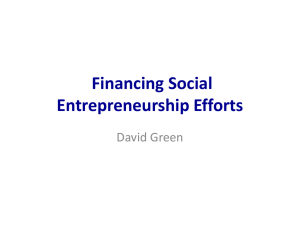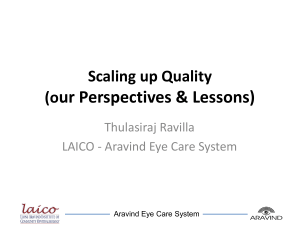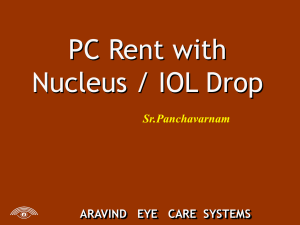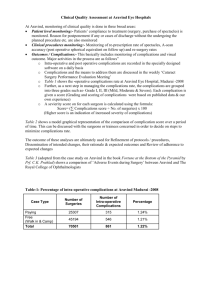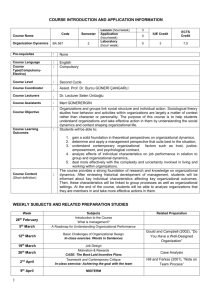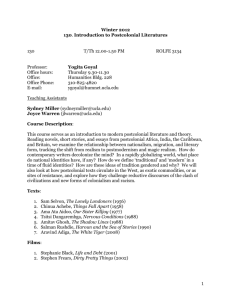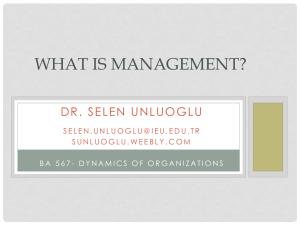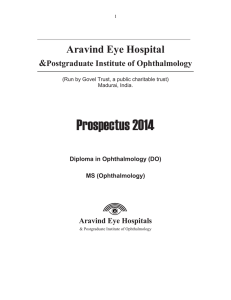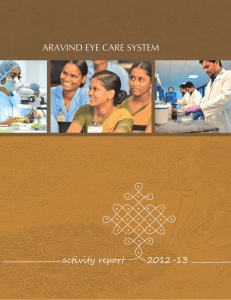Anjali Sastry Fall 2013 Systems Thinking: Aravind 15.232 Business Model Innovation: Global
advertisement
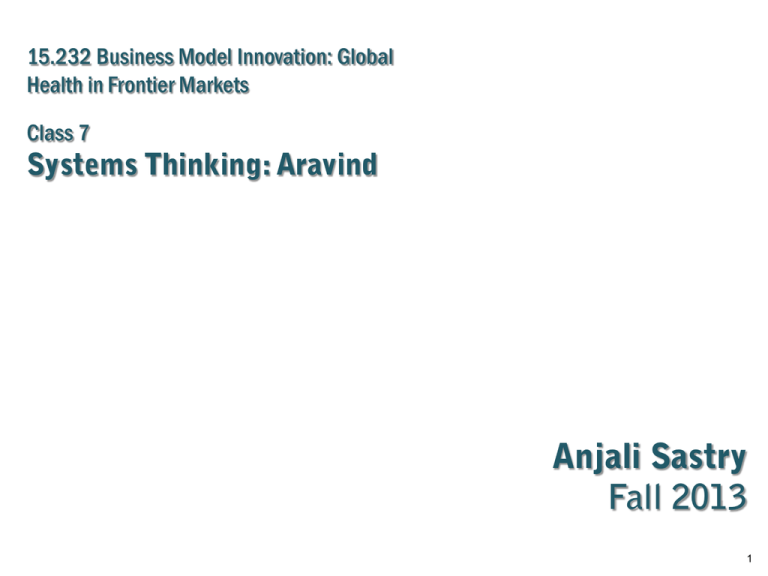
15.232 Business Model Innovation: Global Health in Frontier Markets Class 7 Systems Thinking: Aravind Anjali Sastry Fall 2013 1 Today’s plan • Aravind Eye – – – – Background Outcomes Analysis Does it apply more broadly? • Coming up – Projects (see next) – adding two brief pieces on BRAC to next Tuesday’s required readings to complement the brief Living Goods case and the reading on franchise models 2 Project deliverables • Executive summary • Presentation deck – Include: sources, analysis, and discussion – We provided a ppt template and instructions • Team learning memo (due on last day of class) • Key questions to examine: – – – – What does the organization aim to do? Does it accomplish its goals? What is its business model? What are its strengths and vulnerabilities? • Address the questions as if your team is making a final-round board presentation seeking to be hired as your organization’s next CEO 3 Draft materials • Due via email to Nick next Tuesday, 1 Oct Project Steps TA meeting (and prep) • Sign up for and prepare for meeting with Nick next week. Refined draft materials • Taking into account feedback and discussions, refine your draft materials. • If you want to change your executive summary before your presentation date you MUST make a plan with Nick for exactly when you will get it to him. we send these out at least two days ahead of time to class and guests. • email Nick the deck you will present BY MIDNIGHT BEFORE your assigned day. you will only be able to present a subset of your slides. Hide or remove those you will not show. Hint: to select what to present, first identify the 1 or 2 most valuable pieces of analysis, then show the minimum additional materials needed to support your analysis To prep for the student presentation classes: Read and carefully consider content provided by each of that day’s presenting groups, along with a couple of assigned readings and guest bios. Revised final materials • Taking into account feedback and discussions, refine your revised materials. Due by the last day of class. This material will be uploaded to the web for others to read and download, and so be useful to many others. We can de-identify authors if needed. 4 Photo removed due to copyright restrictions. See India: Aravind Eye Care System on Flickr. 5 Estimated burden of selected diseases and injuries in India in 2004 Figure removed due to copyright restrictions. See p. 415, Patel, Vikram, Ph.D., et al. "Chronic Diseases and Injuries in India." The Lancet 377, no. 9763 (2011): 413-28. Source: Lancet 2011; 377: 413–28 DALYs=disability-adjusted life years. *Includes acute respiratory infections. †Includes disorders arising in the perinatal period (eg, prematurity, birth trauma, and neonatal infections) but not all deaths occurring in the neonatal period (first 28 days). ‡Unipolar major depression and dysthymia. §Vision loss due to glaucoma, cataracts, macular degeneration, and uncorrected refractive errors (vision loss due to infectious causes and injury are included in relevant cause categories). 6 Photo of the Aravind founding team in 2001 removed due to copyright restrictions. See p. 6, Aravind Eye Care System Activity Report, 2010-2011. 7 Aravind Eye Care System Mission To eliminate needless blindness . . . Aravind Eye Hospitals . . . by providing compassionate and high quality eye care for all Lions Aravind Institute of Community Ophthalmology (LAICO) . . . through teaching, training, capacity building, advocacy, research and publications Dr. G. Venkataswamy Eye Research Institute, Aravind Medical Research Foundation . . . by providing evidence through research and evolving methods to translate existing evidence and knowledge into effective action Aravind Eye Banks . . . by reducing corneal blindness through eye banking activities, training, research and public awareness programmes Aurolab . . . by making high quality ophthalmic products affordable and accessible worldwide Aravind Eye Care System activitiy report 2010-11 http://www.aravind.org/downloads/reports/AnnualReport2010_2011.pdf 8 Image removed due to copyright restrictions. See Aravind Eye Care System Milestones. 9 Images removed due to copyright restrictions. See Aravind Eye Hospital Locations, Aravind Eye Care Systems. 10 Figure removed due to copyright restrictions. Infographic showing total outpatient visits and surgeries, p. 9, Aravind Eye Care System Activity Report, 2012-13. In the year ending March 2013, 3.1 million outpatients were treated and over 370,000 surgeries were performed. 11 Screenshots of Total Surgeries & Lasers till March 2009; Financial Results; Surgeon Productivity comparison; Surgical Quality; Number of eye surgeries, ophthalmologists graduating annually, and cost of eye care removed due to copyright restrictions. See Ravilla, Thulasiraj. “How Low-Cost Eye Care Can Be World-Class.” TED Talk. Filmed November 2009, posted December 2009. 12 https://www.youtube.com/watch?v=0d9TftjJAzI&list=PL545006C5F538 5831&index=15 NOTE : the videos I showed in class, which I excerpted from PBS Newshour, are on our YouTube channel: http://www.youtube.com/playlist?list=PL545006C5F5385831 13 HOW DID ARAVIND GET TO THIS LEVEL OF PERFORMANCE? 14 Aravind learned from the challenges it encountered 15 Offslide notes (all linked to points on following slides): occasions for learning from experience • Failed to raise enough money at start – had to take paying patients from the beginning (quality and value proposition focus) – Could build only one story at a time in new building, built more as they raised more (leading to financial discipline?) • Surgical camps did not deliver quality outcomes, so they eliminated them (speaks to their data-driven culture, their willingness to discontinue things, and also allowed them to centralize and control cost and quality via fixed hospitals) • Cost of IOLs rose on the heels of 80’s and 90’s donated lenses—so Aravind had to cut cost dramatically, leading to backward integration AND new revenue streams • Screening camps without transport did not yield patients coming in for even free surgery (under 20% conversion) invested in their own transportation; this infrastructure is now an excellent tool for managing demand on site in hospitals • Looking to further improve cost and quality, they “created competition” and dissemination, training methods 16 During the early years, 1976-78, Dr. V. was not very successful in raising money to support his vision of providing free care for those who would not be able to afford the fee, so he took a detour and arranged to build the ground floor of the “fee-for-service” hospital. But even then the senior management team had the vision to lay the foundation so that the facility could be expanded upwards. From the surplus of the ground floor operation, the first floor was built, and so on, till the fivestory main hospital was readied. The free hospital was built following the completion of the main hospital using the cash flow generated from earned revenues. V. Kasturi Rangan and R.D. Thulasiraj innovations / fall 2007 17 Effectiveness of screening camps? • Aravind reached only 7% of those in need of eye care • Those with rarer eye conditions were not addressed Source: http://www.ted.com/talks/thulasiraj_ravilla_how_low_cost_eye_care_can_be_world_class.html 18 Making Eye Care Affordable • 10 million people see the world through Aurolab’s lenses • Used in 120 countries / 7% of global market • Price of IOL came down from $100.00 to $2.00, making cataract surgery affordable Source: http://www.ted.com/talks/thulasiraj_ravilla_how_low_cost_eye_care_can_be_world_class.html 19 Challenges in the market drove innovation for Aravind • • • • • The need to innovate Market conditions at the “bottom of the pyramid”: Large underserved population Resource scarcity (Capital and HR) Dispersed population Low affordability Poor logistics Source: http://www.ted.com/talks/thulasiraj_ravilla_how_low_cost_eye_care_can_be_world_class.html 20 Aravind (Wo)manpower • Over 300 village high school girls selected each year • Value fit over skill fit Source: http://www.ted.com/talks/thulasiraj_ravilla_how_low_cost_eye_care_can_be_world_class.html 21 Is this explanation from Ravilla sufficient? What we did • Gave away a lot of it for free • Charged market rates for those who can pay • Were helped by market inefficiency Source: http://www.ted.com/talks/thulasiraj_ravilla_how_low_cost_eye_care_can_be_world_class.html 22 23 What are the strategy, management, marketing, and operational FEEDBACK LOOPS behind one of the world’s first (and most) sucessful social enterprises? 24 Why is Aravind excellent? In class exercise • Pull out your copy of Rangan and Thulasiraj and notes from the TED video • Form groups of four-six that include a systemdynamics-enabled peer or two • Develop your own set of causal loop diagrams—take 10 minutes • Focus on the self-reinforcing, virtuous cycles • Aim for operational thinking 25 Are there any limits to these virtuous cycles? 26 Intelligence and capability are not enough. There must also be the joy of doing something beautiful. Being of service to God and humanity means going well beyond the sophistication of the best technology, to the humble demonstration of courtesy and compassion to each patient. - Dr. G.Venkataswamy 27 WHAT IS THE LESSON FOR OTHERS? 28 Guidelines For Evaluating Community Eye Care Work 1. Does the organization work with local eye clinics? Consistent, quality health care must be provided by local eye clinics to the population on a daily basis and year-round. Quality organizations provide support and assistance to local eye clinics. Visiting optometrists and ophthalmologists work collaboratively with local eye doctors and focus on providing training and professional development opportunities. 2. Does the organization provide care by local eye care professionals? All eye care services must be provided by or in collaboration with local eye doctors. 3. Does the organization provide comprehensive eye care for all treatable conditions? The eye care services must be comprehensive, including examinations by local eye doctors, diagnosis and care for all treatable conditions, and education. This full range of services needs to be delivered to the population year-round. 4. Does the organization "refer" patients to local eye doctors, or reduce barriers to ensure that they can access care? Eliminate patient barriers to care by fully funding surgeries, bringing eye care services to the patients, providing transportation from remote villages to the eye clinic for surgery as needed, and educating communities about blindness elimination. 5. Do participating volunteers receive training? All visitors - non-medical or medical professionals - must be trained in cultural competency, volunteer ethics and professionalism, community eye health, and they must understand the logistics and dynamics of the organization and local eye clinic operations. Visitors must be locally led, managed, and supervised by local eye care professionals. 6. Does the organization provide quality medical equipment? Provide quality medical equipment only if and when requested by the local eye clinic. http://www.uniteforsight.org/what-we-do/guidelines-for-eye-care 29 1. Does the organization work with local eye clinics? Worst Practice: Short-term interventions (i.e. optometric medical missions and "surgical safaris") often fail to partner with local eye doctors, thereby undermining the local healthcare systems in developing countries. Additionally, patients who encounter such "medical mission" groups will leave believing they have received a complete ophthalmic exam, no matter how cursory the vision screening, even if they are explicitly told otherwise. If a patient with cataracts, for example, is told that eyeglasses will not correct their sight, but an option for subsidized or free cataract surgery is not provided, the patient will continue to believe that nothing can be done to restore their sight. This visit to the “medical mission” group is often the only time that a patient will seek eye care. Of all the worst practices in global eye-care, short-term surgical missions can be considered the worst offenders. Even the best efforts of the most experienced ophthalmic surgical teams cannot overcome the risks of short-lived surgical missions. Patients receiving surgery must have access to follow-up care in order to prevent or treat infection. When visiting doctors do not work with their local counterparts, there is no ophthalmologist to provide follow-up care or to treat infections that may arise after the operating surgeons depart, which is sometimes the day after operating. When visiting eye doctors do not work with local eye clinics, it undermines the local health care system. Patients may decide to wait until another time a Western doctor visits instead of seeking care by the local ophthalmologist. Oftentimes, it is rich patients who take advantage of free surgical care provided by visiting surgeons despite being able to pay, simply because they incorrectly believe that the Western visitors provide higher quality surgery. “While [Western medical] teams provide temporary but sporadic access to health care, overall, they do not improve long-term access and they may, in fact, undermine existing services. It is unclear whether the short-term projects are treating only individuals who under current circumstances would have absolutely no access to medical care because of an inability to pay for it, or if they are diverting some otherwise paying or potentially paying patients from local practitioners and facilities. Local practitioners who must earn a living in the community cannot compete with the volunteers who donate their services. Furthermore, they cannot provide the same volume of free care over sustained periods and remain financially viable. Because the patient population… has not been closely analyzed, it is difficult to assess the precise impact on the local health care delivery system. If these groups actually do compete with local providers, the possibility exists that they could be put out of business, further restricting access to health care.”(1) (1) Montgomery, L.M. “Short-Term Medical Missions: Enhancing or Eroding Health?” Missiology: An International Review. 21.3 (1993): 333-341. <http://mis.sagepub.com/content/21/3/333.full.pdf> SEE http://www.uniteforsight.org/what-we-do/guidelines-for-eye-care and a free online course on Community Eye Health which focuses on patient barriers to eye care and best practices to eliminate those barriers so that high quality eye care can be provided for all: http://www.uniteforsight.org/community-eye-health-course/ 30 The eyeball is the same in India, Africa, or America 31 Thulasiraj on generalizability The need • large population affected • cuts across all economic strata • equity issues • cost-effective interventions Compassionowning the problem The approach • productivity • focus on quality • patient-centered care • efficiency • cost control • achieving scale 32 More on Aravind • McKinsey Health International, Issue 11 Driving down the cost of high-quality care: Lessons from the Aravind Eye Care System http://www.mckinsey.com/~/media/McKinsey/dotcom/client_servic e/Healthcare%20Systems%20and%20Services/Health%20Internatio nal/HI11_18%20AravindEyeCareSys_R6.ashx • http://www.kingsfund.org.uk/events/past-events-catch-up/annualconference-2011/aravind-eye-care includes video talk • B-school cases abound; some are linked here: http://www.aravind.org/aboutus/casestudiesOnAravind.aspx • Ideo’s Tim Brown uses Aravind as a case example in his piece on Design Thinking: http://www.ideo.com/images/uploads/thoughts/IDEO_HBR_Design _Thinking.pdf 33 MIT OpenCourseWare http://ocw.mit.edu 15.232 Business Model Innovation: Global Health in Frontier Markets Fall 2013 For information about citing these materials or our Terms of Use, visit: http://ocw.mit.edu/terms.
